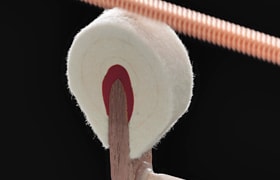CX-Serie
Entwicklerinterview

Das Ziel der CX-Serie: Ein heller Klang, der singt
Wir hatten drei Ziele beim Design der neuen CX-Serie: eine solide Unterstützung für die Verstrebung, ein Resonanzboden, der sich so frei wie möglich bewegt, und einen Ton, der zur Richtung des Klangs passt, der vom Gehäuse des Instruments erzeugt wird. Diese Richtungsgebung ist grundsätzlich die gleiche wie die des Spitzenreiters von Yamaha, des CFX Konzertflügels; man könnte sogar sagen, dass sie auf demselben Konzept basieren.
Für die Modelle C3X und aufwärts – größere Modelle, die ein bestimmtes Volumen erfordern – haben wir die Festigkeit der Verstrebung verbessert, um eine stabile Unterstützung zu gewährleisten, und ein Design entwickelt, das es dem Resoanzboden, der auf der Verstrebung sitzt, ermöglicht, sich frei zu bewegen. Für den Klang haben wir eine neue Art von Saiten verwendet und die Qualität des Hammerfilzes sorgfältig getestet.

Unser Ziel war es, einen Klang zu erreichen, der „hell singt“. Ein einzigartiger Aspekt der CX-Serie ist der Fokus, den wir auf die Bereiche gelegt haben, die für ein Klavier entscheidend sind, wie die Konstruktion des Resonanzbodens, der daraus entstehende Ton und das Äußere des Instruments. Von allen Änderungen, die Yamaha-Flügel in den letzten Jahrzehnten durchlaufen haben, stellt diese Serie die umfassendste Verbesserung dar, und in der Folge wurde die Musikalität dieser Flügel erheblich gesteigert.
Wir wollten einen Resonanzboden schaffen, der den Wunsch hat zu singen und Klang zu erzeugen
Genau wie bei der CF-Serie lag unser Forschungsschwerpunkt auf der Kontrolle der inneren Spannungen innerhalb des Resonanzbodens, und wir konnten bedeutende Fortschritte erzielen. Der resultierende Klang bietet eine schnelle Ansprache, einen hellen Ton und klare Harmonien. Wir sind der Überzeugung, dass die Verbesserung der Ansprache des Resonanzbodens entscheidend ist. Dies bedeutet die Steigerung der Effizienz seiner akustischen Strahlung. Auf diese Weise können die Qualitäten des Instruments optimal zur Geltung gebracht werden. Gleichzeitig wird eine breitere Ausdruckspalette ermöglicht.
Im Wesentlichen möchten wir Instrumente schaffen, die singen wollen, Instrumente, die Klang erzeugen wollen. Statt Instrumente zu schaffen, bei denen man wirklich arbeiten muss, um einen Klang hervorzubringen, wollten wir Flügel entwerfen, deren Resonanzboden und Gehäuse tatsächlich den Wunsch haben zu singen und Klang zu erzeugen. In diesem Sinne reagiert dieser Resonanzboden mit seiner neuen Struktur gut auf jegliche Eingabe, und wir glauben, dass er eine viel breitere Ausdruckspalette in seiner Reaktion bietet.

Saiten, die reine Harmonien erzeugen; Hammerfilz mit einem reichen Ton.
Als nächstes mussten wir entscheiden, welchen Klang wir diesem „singenden“ Körper und diesem Resonanzboden mit seiner hervorragenden Ansprache verleihen sollten. Zwei der Hauptfaktoren für diesen Klang waren die Saiten und die Hämmer. Für diese Serie wählten wir Musikdraht (Saiten) mit schönen Obertönen und klaren Harmonien, guter Ausdauer und einem Ton, der trägt. Wir besorgten uns Filzblätter, die wir als „Rohmaterial“ bezeichnen, und fertigten die Klavierhämmer bei Yamaha. Der in der CX-Serie verwendete Filz wird sorgfältig geprüft und ist äußerst widerstandsfähig, wodurch er einen vollen, tiefen Ton erhält. Die Kombination aus diesem Musikdraht und dem Hammerfilz hat die Einzigartigkeit der CX-Serie weiter verbessert.

Designer sind ständig von dem Wunsch getrieben, noch bessere Instrumente zu schaffen.
Ein Klavier ist ein äußerst komplexes System, das aus einer Vielzahl von Einzelteilen besteht. Zudem wird der Klang eines Flügels erheblich durch Unterschiede im Holz und in den natürlichen Materialien, aus denen es gebaut ist, sowie durch die Bedingungen, unter denen es gespielt wird, beeinflusst – selbst Regenwetter verändert den Klang eines Klaviers. Der Klang eines Flügels kann auch je nachdem variieren, wer es stimmt. Beim Design eines so empfindlichen Instruments wie eines flügels, das von so vielen Variablen beeinflusst wird, ist es entscheidend, den Einfluss solcher Faktoren wie der Umgebung zu minimieren. Daher ist es unerlässlich zu verstehen, wie man diese Faktoren berücksichtigt, sowie die Handwerkskunst und Produktionsfähigkeiten zu besitzen, um Instrumente zu schaffen, die keine Unterschiede aufweisen.

Es ist auch wichtig, Flügel während des Entwicklungsprozesses korrekt zu bewerten. Dies tun wir nicht selbst; stattdessen lassen wir erstklassige Pianisten spielen und ihre Meinungen einholen. Dies bringt manchmal Aspekte zutage, die uns als Entwicklern nicht bewusst waren, weshalb wir auf die Sammlung dieser Informationen besonders Wert legen. Schon ein einziger Fehler in diesem Prozess kann dazu führen, dass ein Flügel mit vielen guten Eigenschaften eine schlechte Bewertung erhält. Um den Spielraum für Fehler so gering wie möglich zu halten, halte ich es für wichtig, die technische Fähigkeit zu besitzen, denselben Erfolg im Produktionsprozess zu erzielen – unabhängig davon, wie oft dieser durchgeführt wird –, um eine positive und genaue Bewertung dieser guten Eigenschaften zu erhalten.
Jedoch glaube ich nicht, dass ein Designer jemals sagen würde, dass ein Instrument perfekt ist und dass er völlig zufrieden ist. Instrumente existieren im Kontext musikalischer Ausdruckskraft, und Musik selbst hat keine Grenzen. Wenn man an all die verschiedenen Musikrichtungen denkt, ist es fast unmöglich, dass ein einzelnes Instrument „das beste“ ist. Auch jetzt denke ich oft: „Hmmm... wenn ich nur dies oder das anders gemacht hätte, wäre dieses Instrument etwas Großartiges geworden“ oder „Wenn ich einen Weg finden könnte, wie das Instrument mit dieser Nuance die Darbietung unterstützen könnte, wäre es musikalisch ausdrucksstärker.“ Während wir diese Flügel entwickeln, haben wir Designer immer die Vorstellung eines viel, viel besseren Instruments; unser Drang, mehr zu erreichen, kennt wahrscheinlich keine Grenzen.

Yutaka Matsuki
Leiter der Klavierdesign-Abteilung.
Trat 1992 bei Yamaha ein. Nach Beginn seiner Tätigkeit bei Yamaha war Matsuki hauptsächlich mit der Entwicklung von Klavieren betraut und war an der Schaffung des SU7 und anderer Instrumente beteiligt. Nach zusätzlicher Erfahrung in der Entwicklung von Konzertflügeln wurde er gebeten, an der Entwicklung der CF-Serie zu arbeiten, die 2010 veröffentlicht wurde.
Derzeit ist Matsuki an der Entwicklung der Kernbereiche beteiligt, die akustischen Klavieren ihre grundlegenden Leistungseigenschaften verleihen.






